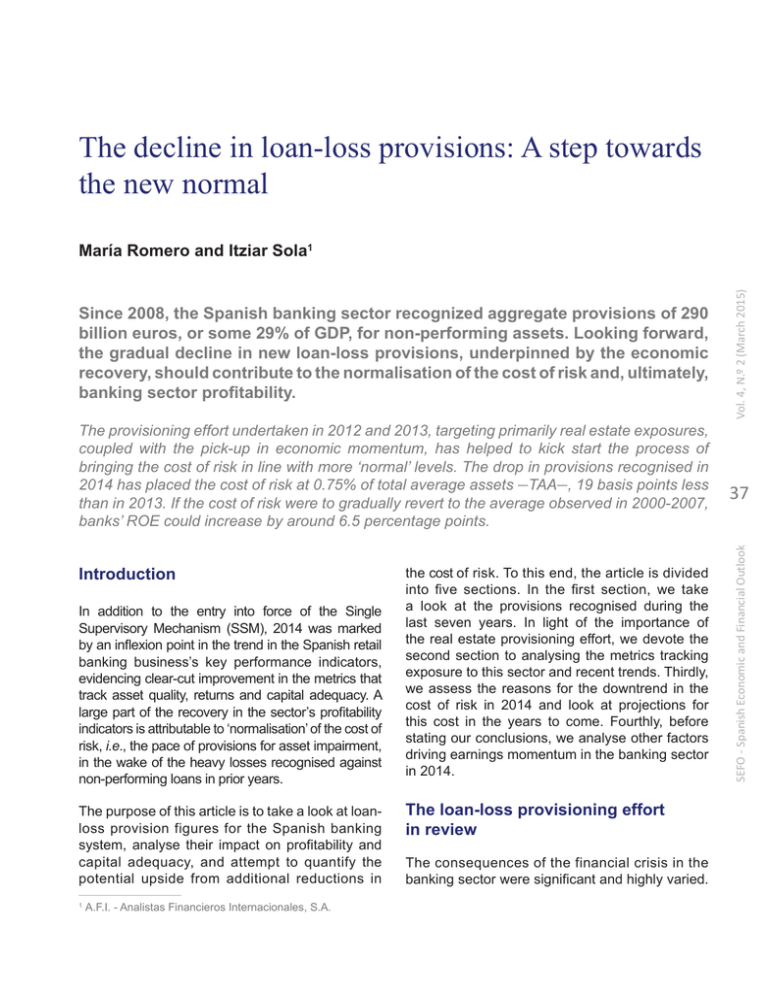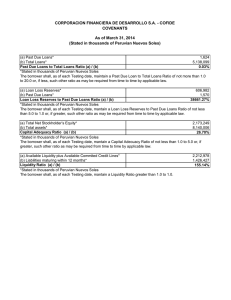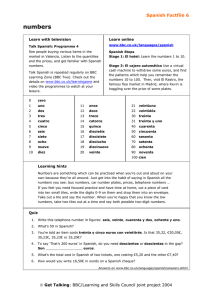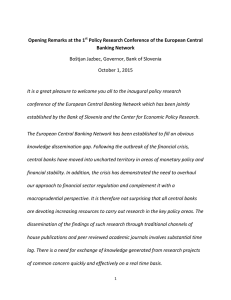The decline in loan-loss provisions: A step towards the new
Anuncio

The decline in loan-loss provisions: A step towards the new normal The provisioning effort undertaken in 2012 and 2013, targeting primarily real estate exposures, coupled with the pick-up in economic momentum, has helped to kick start the process of bringing the cost of risk in line with more ‘normal’ levels. The drop in provisions recognised in 2014 has placed the cost of risk at 0.75% of total average assets —TAA—, 19 basis points less than in 2013. If the cost of risk were to gradually revert to the average observed in 2000-2007, banks’ ROE could increase by around 6.5 percentage points. Introduction In addition to the entry into force of the Single Supervisory Mechanism (SSM), 2014 was marked by an inflexion point in the trend in the Spanish retail banking business’s key performance indicators, evidencing clear-cut improvement in the metrics that track asset quality, returns and capital adequacy. A large part of the recovery in the sector’s profitability indicators is attributable to ‘normalisation’ of the cost of risk, i.e., the pace of provisions for asset impairment, in the wake of the heavy losses recognised against non-performing loans in prior years. The purpose of this article is to take a look at loanloss provision figures for the Spanish banking system, analyse their impact on profitability and capital adequacy, and attempt to quantify the potential upside from additional reductions in 1 A.F.I. - Analistas Financieros Internacionales, S.A. the cost of risk. To this end, the article is divided into five sections. In the first section, we take a look at the provisions recognised during the last seven years. In light of the importance of the real estate provisioning effort, we devote the second section to analysing the metrics tracking exposure to this sector and recent trends. Thirdly, we assess the reasons for the downtrend in the cost of risk in 2014 and look at projections for this cost in the years to come. Fourthly, before stating our conclusions, we analyse other factors driving earnings momentum in the banking sector in 2014. The loan-loss provisioning effort in review The consequences of the financial crisis in the banking sector were significant and highly varied. 37 SEFO - Spanish Economic and Financial Outlook Since 2008, the Spanish banking sector recognized aggregate provisions of 290 billion euros, or some 29% of GDP, for non-performing assets. Looking forward, the gradual decline in new loan-loss provisions, underpinned by the economic recovery, should contribute to the normalisation of the cost of risk and, ultimately, banking sector profitability. Vol. 4, N.º 2 (March 2015) María Romero and Itziar Sola1 María Romero and Itziar Sola SEFO - Spanish Economic and Financial Outlook 38 This article focuses on the banking sector’s provisioning effort. In practice, the extraordinary provisions required under successive pieces of legislation can be considered a thing of the past, other than some potential additional requirements related to the bank inspection processes. Meanwhile, ordinary or recurring loan-loss provisions have already begun to reverse course, although there is still some way to go before we reach precrisis NPL ratios. equivalent to 1.6x equity as of December 2007. In addition, the banks that underwent restructuring recognised 22 billion euros of impairment provisions against reserves. As a result, the Spanish banking system recognised aggregate asset impairment provisions of close to 290 billion euros (17.1% of the outstanding credit balance) in the seven years following the start of the crisis. However, these figures mask highly uneven The asset impairment provisions recognised by the Spanish banking system since 2008 amount to 290 billion euros, 17.1% of the credit outstanding at the start of the crisis. performances among the various banks, with a range between 4% and 48% of loans. Between 2008 and the third quarter of 2014 (last available data), Spain’s deposit-takers recognised 265 billion euros of loan-loss provisions against profit or loss, i.e., 26.5% of GDP or 15.7% of the credit outstanding at the start of the crisis. In terms of capital, these 265 billion euros of provisions are Nor were the provisions recognised evenly over time. Forty-four per cent were recognised in 2012, under the regulatory requirements stipulated in Royal Decree-Laws 2/2012 and 18/2012 on financial system restructuring. Those regulations emphasised the need to heavily provision Exhibit 1 Exhibit 2 Distribution in time of provisions against earnings Provisions by origin (EUR billions) 120 22 Specific provisions against reserves under restructuring process 100 80 € bn Vol. 4, N.º 2 (March 2015) As well as triggering intense sector consolidation and a sharp reduction in supply, a large number of entities had to modify their business models more than once and introduce stiffer internal governance controls. However the most significant consequence in quantitative terms was probably the large asset provisioning effort and the related sector recapitalisation process. € 290 bn 265 Impairments charged to P&L 17.1% of loans 60 40 20 0 2008 2009 2010 Financial assets Source: AFI based on Bank of Spain figures. 2011 2012 2013 2014 Other assets Source: AFI estimates based on Bank of Spain and sector entity figures. exposure to the real estate sector, hardest hit by the economic crisis. In total, these pieces of legislation obliged the recognition of 65 billion euros of provisions, most of which were charged against 2012 earnings, triggering sizeable sector losses, to the tune of close to 74 billion euros. In order to anticipate other potential sources of uncertainty regarding credit risk, in 2013, new provisioning requirements were introduced with respect to refinanced and restructured loans. These loans totalled around 180 billion euros at the time, equivalent to around 13% of outstanding credit. Generally speaking, these loans had to be classified as substandard although they could also be reclassified as doubtful or even as performing under certain conditions. The impact of this measure on earnings was around 8.7 billion euros, significantly smaller than the hit taken in 2012 with respect to real estate exposures. The breakdown of impairment losses by loan segment was similarly skewed. As is to be expected, NPL coverage ratios are by far the highest in the construction and property development segment in the wake of the hefty provisions recognised in 2012 (more on this later on in this report). NPL coverage ratios in other segments such as consumer credit and loans to other non-financial corporations are very low (6% and 4%, respectively). However, the segment carrying the lowest level of specific loanloss provisions is the home mortgage segment (2%) (although the value of the collateral needs to be factored in to give a fairer picture of coverage in this segment). Table 1 summarises the trend in the main asset quality indicators, such as the cost of risk, nonperformance ratios, foreclosed assets and NPL coverage ratios. Vol. 4, N.º 2 (March 2015) The decline in loan-loss provisions: A step towards the new normal 39 Table 1 2000 2001 2002 2003 2004 2005 (1) NPL ratio 1.0 0.9 0.9 0.8 0.7 0.7 (2) Damaged assets ratio n.a. n.a. n.a. n.a. n.a. n.a. (3) Coverage doubtful loans ratio 2006 2007 2008 2009 2010 2011 0.6 0.8 3.3 5.0 5.8 7.9 n.a. n.a. n.a. n.a. n.a. 228.1 266.8 268.3 326.3 383.5 308.8 324.9 246.0 75.5 62.0 2012 2013 2014 10.6 13.8 12.6 7.9 14.9 18.3 17.9 69.9 61.4 76.0 59.7 59.9 (4) Coverage loans ratio 2.2 2.5 2.5 2.7 2.7 2.1 2.0 2.1 2.5 3.1 4.0 4.9 8.0 8.2 7.6 (5) Coverage foreclosed assets ratio n.a. n.a. n.a. n.a. n.a. n.a. n.a. n.a. n.a. n.a. n.a. 42.2 48.0 48.3 48.5 (6) Cost of risk (% TAA) 0.2 0.3 0.3 0.3 0.3 0.2 0.3 0.4 0.5 0.9 0.7 1.4 3.5 0.8 0.5 (7) Cost of 0.3 0.5 0.4 0.5 0.5 0.3 0.4 0.4 0.7 0.9 0.8 1.1 4.2 1.2 0.7 risk (% loans) (1) Doubtful loans to private sector / loans to private sector, gross. (2) (Doubtful loans to private sector + foreclosed assets, gross) / (loans to private sector, gross + foreclosed assets, gross). (3) Impairment allowances / Doubtful loans to private sector. (4) Impairment allowances / Loans to private sector, gross. (5) Impairment allowances for foreclosed assets / Foreclosed assets, gross. (6) Assets impairments / Total average assets. (7) Financial assets impairments / Average loans to private sector, gross. Sources: AFI based on Bank of Spain, CNMV and sector entity figures. SEFO - Spanish Economic and Financial Outlook Asset quality metrics (Percentage) María Romero and Itziar Sola Provisions in the real estate sector Vol. 4, N.º 2 (March 2015) Banks’ exposure to the real estate sector has virtually been halved as a result of the crisis, boosted by the transfer of around 100 billion euros of toxic assets to SAREB, Spain’s so-called bad bank, between 2012 and 2013. According to the latest figures published in the 2014 financial SEFO - Spanish Economic and Financial Outlook 40 Banks’ exposure to the real estate sector has virtually been halved as a result of the crisis. statements presented by the eight listed banks (which represent 67% of overall banking sector assets), exposure to the construction and property development sector fell by around 10 billion euros in 2014 (by 7% year-on-year) to 147 billion euros. This drop is mainly attributable to a shrinking loan book, particularly loans classified as doubtful (these declining from 56 billion euros in 2013 to 46 billion euros in 2014); this pattern echoes the trend witnessed in other sectors of the banking business and is consistent with the improvement seen in construction sector activity indicators and employment for the first time since the start of the crisis. This sharp drop in real estate loans offset the 10% year-on-year increase in foreclosed assets, which stand at 76.6 billion euros in 2014 (equivalent to 8.8% of the total customer loan book). In addition to this reduction in ‘problematic’ assets, it is worth highlighting the provisioning effort made to date, albeit heavily concentrated in 2012, as a result of legally-mandated impairment provisioning requirements in this segment. By the end of 2014, over 40% of these eight banks’ exposure to the construction and property development sector had been provisioned; this percentage rises even higher in the case of doubtful loans or foreclosed assets, averaging 50% in these instances. These By the end of 2014, over 40% of the banks’ exposure to the construction and property development sector had been provisioned. NPL coverage ratios for doubtful loans and foreclosed assets average an even higher 50%. coverage levels can be considered reasonable and even sufficient at present as the impairment of real estate assets seems to have run its course. According to the Ministry of Development, housing prices, for example, rose in the fourth quarter of 2014, after 26 consecutive quarters of declines, prices having corrected by 30% since the start of the crisis. Table 2 Bank exposure(*) to the construction and property development sector 2014 Gross Allowances Net Gross % coverage € Million € Million 24,930 35.1 46,151 -17,617 712 3.9 17,595 -4,133 46,151 22,505 48.8 23,646 -10,206 6,623 1,713 25.9 4,910 -3,278 76,661 37,169 48.5 39,492 7,092 147,741 62,099 42.0 85,643 -10,525 € Million € Million Loans 71,081 Normal 18,307 Doubtful Substandard Foreclosed assets TOTAL Var. 2014-13 Note: (*) These figures represent the aggregate for the seven listed Spanish banks: Santander, BBVA, Caixabank, Bankia, Sabadell, Popular, Bankinter and Liberbank. Source: AFI, based on the banks’ annual reports. The decline in loan-loss provisions: A step towards the new normal In our opinion, the provisioning efforts made in 2012 and 2013, in addition to being totally necessary, crystallised future provisioning requirements and In 2014, the cost of risk narrowed by 19 basis points as a result of the drop in non-performance and the incipient economic recovery. The increase in sector profits is explained mainly by the decline in loan-loss provisions. accelerated the start of the cost of risk normalisation process. However, some banks, either out of Although provisions were substantially lower than in 2012-13, they remain high, which is why they should gradually revert to pre-crisis levels as the economic situation improves. During 2000-2007, the average cost of risk was 0.30% in terms of TAA, rising to 0.43% when relativized on lending. This process is correlated to asset quality and, in short, the trend in non-performing debt, which in turn depends on exogenous and endogenous factors. As for the former, the crisis which erupted in the summer of 2007 has highlighted the tight correlation between the economic cycle and the quality of bank assets, so that the trend in non-performing debt should be largely dictated by cyclical factors. In addition, in the current phase of economic recovery, the banks may well accelerate, on their own initiative, the pace of impaired asset reduction by selling portfolios of doubtful loans or similar transactions. Exhibit 3 Flow of doubtful loans Initial doubtful loans + New formation NPL - Derecognitions = Final doubtful loans Recoveries Write-offs Foreclosures Portfolio sales Source: AFI. This article uses the terms ‘doubtful’ and ‘non-performing’ interchangeably, even though according to the Bank of Spain, the former is a broader concept than the latter as it includes, in addition to non-performance, arrears of over 90 days and other events, such as borrower credit protection filings. 2 Vol. 4, N.º 2 (March 2015) For the first time since the start of the crisis, in 2014 the balance of doubtful credit2 of deposit-takers as a whole narrowed by some 24.3 billion euros to 167.47 billion euros. The NPL ratio ended the year at 12.6%, 116 basis points below the peak of December 2013. The improvement in the macroeconomic situation, evidenced by annual GDP growth of 1.4% in 2014 and modest recovery in the job market, was key to the reduction in additions to non-performing loans in 2014, driving a reduction in loan impairment losses. caution or due to accounting requirements, increased provisions with respect to 2013 in order to increase their foreclosed asset coverage ratios. In total, the cost of risk, measured as the ratio of impairment losses on all assets to total average assets, fell by 19 basis points to around 0.75%. 41 SEFO - Spanish Economic and Financial Outlook Normalisation of the cost of risk María Romero and Itziar Sola SEFO - Spanish Economic and Financial Outlook 42 ■■New formation of non-performing loans: new formation of non-performing loans declined, approximately, by 47% in 2014, due mainly to the improvement in the economic situation. It is worth recalling the non-performing loans inflows in 2013 reflected an extraordinary impact arising from the refinanced loans review process, forcing reclassification of part of them as doubtful. The contribution of the risk management effort to the decline in new inflows of non-performing loans in 2014 is considered marginal. ■■Derecognitions from non-performing: here cyclical and internal management factors come into play. ●●Recoveries: in the majority of Spanish listed banks, recoveries were higher than new formation in 2014. This growth in recoveries is attributable mainly to the improved economic outlook, but also to effective management of the recovery process. Going forward, portfolio sales will depend on the banks’ strategies and investor appetite for Spanish credit risk. Recall that one of the recommendations issued by international organizations in this area is that of fostering the development of an international market for non-performing credit portfolios. Looking forward, we anticipate a gradual reduction in the pace of new loan-loss provisions and an improvement in recovery rates underpinned by the outlook for economic recovery, all of which will contribute to the normalisation of the cost of risk and, ultimately, growth in sector profitability. The feasible cost of risk target and the year by which it can be achieved will depend on each If the cost of risk were to gradually return to the 2000-2007 average, banks’ ROE could increase by around 6.5 percentage points. entity’s starting position and strategic planning. That being said, the average cost of risk between Exhibit 4 Doubtful loans (YoY) ●●Write-offs: according to our estimates, around 10 billion euros of bad loans were written off in 2014. Loans are written off when they are fully provisioned and within a timeframe of 48 months, making it an internal decision taken by the banks. ●●Foreclosures: foreclosures are the last stage in the process of calling in a mortgage guarantee and therefore depend on a court ruling. ●●Portfolio sales: in 2014 several banks carried out transactions of this kind, most notably Catalunya Banc in terms of the transaction size —3 billion euros— and the importance of the deal (a prerequisite for its subsequent acquisition by BBVA). In total, transactions of this nature amounted to 5 billion euros. 60 50 40 30 € bn Vol. 4, N.º 2 (March 2015) In order to determine whether the reduction in the cost of risk observed in 2014 as a result of the drop in the balance of doubtful credit really reflects an improvement in asset quality, we need to analyse doubtful loan flows, i.e. additions to and reversals of loan losses. 20 10 0 -10 -20 -30 2007 2008 2009 2010 2011 2012 2013 2014 Natural evolution Transfer to Sareb Source: AFI based on Bank of Spain figures. The decline in loan-loss provisions: A step towards the new normal Exhibit 5 Exhibit 6 4.0% 20% ROE Cost of risk (% TAA) 3.5% 10% 3.0% Vol. 4, N.º 2 (March 2015) 0% -10% 2.0% 1.5% -20% 1.0% 2014 2013 2012 2011 2010 2009 2008 2007 2006 2005 2004 2003 2002 2001 2014 2013 2012 2011 2010 2009 2008 2007 2006 2005 2004 2003 2002 2001 -40% 2000 0.0% 2000 -30% 0.5% Source: AFI based on Bank of Spain figures. Source: AFI based on Bank of Spain figures. 2000 and 2007 (0.3% of TAA or 0.43% over loan book) can be considered a good proxy for the sector target. This suggests significant upside with respect to the 0.75% cost estimated at year-end 2014. If the cost of risk were to return to the 20002007 average, the sector’s ROE stands to increase by 6.5 percentage points. ■■Growth in net interest income. Net interest income staged a clear-cut recovery quarter after quarter in 2014. The main source of this growth was the 73 basis point annual reduction in the average cost of term deposits held by households and companies, which represent almost 20% of system funding, mainly thanks to beneficial repricing of the long-term deposits captured in 2012. Switches from term deposits into demand deposits in light of the low returns offered by the former, coupled with the drop in interest rates, helped lower funding costs. The trend in the cost of risk will also be shaped by the trend in the volume of foreclosed assets. Although this balance increased by 10% in 2014, as seen earlier, the volume of foreclosed assets can be expected to decline in the months to come in the wake of economic recovery in general and the sale of properties and other real estate assets in particular. Other earnings drivers in 2014 In addition to the downtrend in the cost of risk, other factors can be attributed to driving earnings momentum in the Spanish banking sector last year: 43 On the asset side of the equation, despite an annual drop in interest rates of around 20 basis points, the average return on the loan book only narrowed by 12 basis points to 3.08% as loan repricing tends to lag deposit repricing. The drop in NPL ratios also helped prop up interest income. Elsewhere on the lending front, competition picked up in the second half of 2014, exerting downward pressure on asset margins; while this helps to reduce financial fragmentation, it will not help banks’ income statements in the years to come. SEFO - Spanish Economic and Financial Outlook 2.5% Vol. 4, N.º 2 (March 2015) María Romero and Itziar Sola SEFO - Spanish Economic and Financial Outlook 44 The most telling credit statistic, however, is unquestionably the fact that, even though the aggregate loan book continues to shrink (logical in light of Spanish economic agents’ leverage levels), 2014 was marked by a turnaround (double-digit growth) in new lending activity in most segments (other than large companies). Although the new loan figures provided by the Bank of Spain include refinancings, we believe that this shift in trend should be read positively insofar as it implies more dynamic lending activity. Against the backdrop of scant growth in credit, intense competition and abundant liquidity via ECB injections, management of asset and liability spreads will be crucial to generating net interest income. ■■Lower operating expenses. Intense supply-side contraction, marked by the closure of around 13,400 branches (approx. 30%) and the loss of more than 58,000 jobs ( approx. 22%) between 2008 and 2014, characteristic of a mature sector, drove a reduction in aggregate sector operating expenses in 2014. However, some banks saw Exhibit 7 their expenditure increase on the back of new process launches. ■■Other non-recurring factors. In addition, many entities continued to generate income from financial transactions, mainly monetising gains on fixed-income portfolios via their sale in order to offset trends in other income statement headings. While these transactions boost income in the year in which they are realised, they also jeopardise trading income going forward. In our opinion, they evidence the difficulties faced by the banks in generating recurring profits. Another factor that had a positive impact on sector earnings growth in 2014 was a change in accounting regulations: specifically application of IFRIC 21, which requires recognition of levies in the year in which the obligation is assumed. This change required the restatement of the 2013 financial statements, increasing the operating charges recognised with respect to contributions to the Deposit Guarantee Fund that year. This effect had an impact on aggregate profit (after tax) of 35%. Table 3 Average cost of retail deposits New loans € Million 3.0% 2011 2012 2013 2014 2014 (YoY) Housing purchase 36,065 31,242 21,367 26,228 22.8% Consumption and other 29,486 24,867 22,812 26,434 15.9% 158,172 132,202 121,931 134,369 10.2% 2.42% 2.5% 2.0% 1.69% 1.5% 1.0% SME 0.5% 0.0% Back book Front book NFC, other than SME 335,701 313,664 245,494 202,816 -17.4% TOTAL 559,424 501,975 411,604 389,847 Back book (annual average) Source: AFI based on Bank of Spain figures. Source: AFI based on Bank of Spain figures. -5.3% The decline in loan-loss provisions: A step towards the new normal Using the 2000-2007 average (0.3% of TAA) as a proxy for the cost of risk target implies scope for additional improvement of around 45 basis points. In terms of shareholder returns, normalisation of the cost of risk could boost banks’ ROE by 6.5 percentage points. In addition to the improvement in the economic situation, the legally-mandated real estate and refinanced/restructured asset provisions recognised by the banks in 2012 and 2013, respectively, have also played a role in accelerating the start of a downtrend in the cost of risk. 45 SEFO - Spanish Economic and Financial Outlook The reduction in the cost of risk in 2014 fuelled banks’ earnings momentum. The trend in asset impairment provisions going forward will be shaped by the economic environment as well as internal decision-making with a view to offloading impaired assets. The economic situation will affect new loan-loss provisions above all. Accordingly, to the extent that the economic recovery gathers traction, the pace of new loan losses will slow, lowering the cost of risk in the process. Vol. 4, N.º 2 (March 2015) Conclusions




